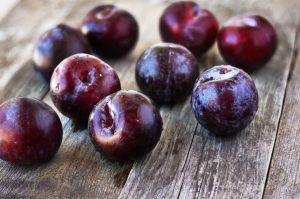Making fruit wine at home is a popular pursuit, and making plum wine may be the most popular of them all. Plums are a delicious and versatile fruit for eating and cooking, though for us the best use of plums is in winemaking. The internet has a whole host of recipes and techniques for making plum wine and what to do with it. In this handy guide we’ll outline the easiest way to make plum wine, some recipes for cooking with plum wine and some alternatives to plum wine!

Did you know that you can make plum wine?
How to make plum wine
This recipe for making plum wine is simple and straightforward. The ingredients are simple, though you may need to invest a little in the equipment. If you are serious about making wine at home, it’s a very worthwhile investment: This is the sort of equipment that can also be used for home brewing, making elderberry wine and other fruit wines.
Ingredients you’ll need to make plum wine
- 2.25kg plums
- 1.35kg sugar
- 1 gallon of water
- 1 tsp lemon juice
- Wine yeast
The equipment you’ll need to make plum wine
- A 5 gallon plastic fermentation barrel with lid
- Plastic tubing
- Funnel
- A 1 gallon demijohn
- Rubber bung and airlock
- Bottles and stoppers (it should fill about 6 bottles)
Step-by-step guide to make plum wine
- Wash the plums, cut each in half and add them to the fermentation barrel. Note that you have two choices here: Either leave the stones in for an almond-like flavour, or remove them altogether to get a purer expression of the fruit flavour.
- Add boiling water, pour over the plums. Seal the barrel with the lid and leave for four days, stirring once each day.
- Add lemon juice and sugar. Stir well, then sprinkle the yeast over the miwture. Seal the barrel once again and leave somewhere warm for another four days. Stir once a day during this time.
- Using the siphon hose and funnel, move the mixture to the demijohn. Avoid placing the hose at the very bottom of the barrel, or else you’ll suck up excessive sediment. Seal the demijohn with an airlock.
- Store the wine somewhere cool and dry to age. The wine will clear over time, at which point it is ready to be bottled.
- Your homemade plum wine is best enjoyed at around 12 months of age, though you can also drink it younger. Enjoy!
2 great recipes for cooking with plum wine
So, let’s say you’ve succesfully made your own plum wine. Congratulations! Maybe you’ll drink it all, give some of it away as gifts, sell it at a market or something else entirely. Our favourite use for plum wine – other than drinking, of course – is cooking with it! There are some really interesting plum wine food recipes out there, and we’ve picked out two of the best!

Cooking with plum wine is a lot of fun!
1. Plum wine cake
Cake made with plum wine is rich and delicious. Season of Sweets has this recipe, which calls for:
- Flour
- Baking powder
- Salt
- Plum wine
- Sour cream
- Sugar
- Butter
- Canola oil
- Eggs
Check out the full recipe above, or this alternative recipe from Duncan Hines. Happy baking!
2. Poached plums in plum wine sauce
This recipe from Lauren Groveman’s Kitchen goes all-in on plums. The recipe provides specific information regarding seasonality and technique, but for a start you’ll need:
- Sugar
- Water
- Star anise
- Ginger
- Cinnamon stick
- Orange peel
- Plum wine
- Plums
- Yoghurt or ice cream
Get the full recipe above and make the most of your homemade plum wine.
And if you don’t want to make plum wine at all…
Sounds simple, right? However, we don’t all have the time or the energy. Perhaps you don’t want to invest in the winemaking equipment. Or perhaps you just want to drink plum wine now! Luckily, there are lots of wines out there which have beautiful plummy flavours.
Plum wine alternatives
- A young Tempranillo has the juicy, fleshy, and slightly tart style reminiscent of biting into a ripe plum. In Rioja, you’ll often find Tempranillo grapes blended with the likes of Mazuelo or Garnacha, combining ripe plums, with prunes and a little hint of leather, a bit of vanilla and some spice.
- For easy drinking, Merlot generally has less tannin and you’ll find plums mixed with herbal and black cherry flavours. Merlot and Tempranillo can make a nice blend, with the Merlot providing smoothness to Tempranillo’s forest fruits.
- A lovely complex option would be a Garnacha, which is aged longer than many Tempranillos and has a bolder style, marrying plum with blackberry, liquorice and raspberry.
Whether you decide to make your own, or you look out for a wine with plummy flavours, the ripe, comforting taste of plum can’t be beaten as summer turns to autumn. Nothing beats curling up in front of the fire after an autumnal walk, with a nice plum wine!
Have you ever made plum wine at home? Tell us about your experience!
[cta_generico id=2584]


